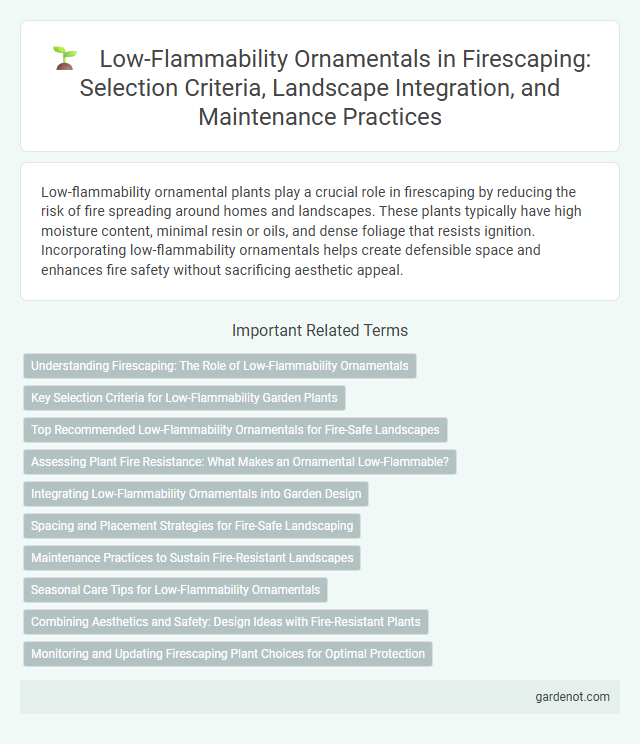Low-flammability ornamental plants play a crucial role in firescaping by reducing the risk of fire spreading around homes and landscapes. These plants typically have high moisture content, minimal resin or oils, and dense foliage that resists ignition. Incorporating low-flammability ornamentals helps create defensible space and enhances fire safety without sacrificing aesthetic appeal.
Understanding Firescaping: The Role of Low-Flammability Ornamentals
Low-flammability ornamentals play a crucial role in firescaping by reducing the risk of wildfire ignition near properties. Plants such as succulents, lavender, and rockrose contain high moisture content and low volatile oils, making them less prone to ignite and spread flames. Incorporating these fire-resistant species in landscape design enhances property protection and supports fire-safe vegetation management.
Key Selection Criteria for Low-Flammability Garden Plants
Key selection criteria for low-flammability garden plants include high moisture content in leaves, minimal volatile oils, and dense, non-resinous foliage to reduce ignition risk. Opt for species with open, airy structures that limit fuel continuity and encourage slow-burning characteristics, such as succulents, deciduous trees, and broad-leafed shrubs. Prioritize plants native to fire-prone regions that have adapted with natural fire resistance, ensuring effective landscape fire mitigation and safety.
Top Recommended Low-Flammability Ornamentals for Fire-Safe Landscapes
Top recommended low-flammability ornamentals such as lavender (Lavandula spp.), California lilac (Ceanothus spp.), and manzanita (Arctostaphylos spp.) provide fire-safe landscaping solutions by reducing ignition risks. These species feature low resin content, minimal volatile oils, and moisture-retaining foliage that create natural firebreaks. Incorporating these drought-tolerant, visually appealing plants enhances both aesthetic value and wildfire resilience in residential landscapes.
Assessing Plant Fire Resistance: What Makes an Ornamental Low-Flammable?
Assessing plant fire resistance involves evaluating factors such as moisture content, volatile oil levels, and leaf thickness to determine low-flammability ornamentals. Species with high water content, minimal resin or aromatic compounds, and dense, succulent leaves typically exhibit superior fire resistance. Selecting native or well-adapted plants like succulents, deciduous shrubs, and broadleaf evergreens contributes to effective firescaping by reducing ignition risk in fire-prone landscapes.
Integrating Low-Flammability Ornamentals into Garden Design
Integrating low-flammability ornamentals into garden design enhances fire resilience by selecting plants with high moisture content and minimal volatile oils. Species such as succulents, deciduous trees, and certain herbaceous plants create natural firebreaks while maintaining aesthetic appeal. Strategic placement of these ornamentals around structures reduces ignition risk and supports sustainable, fire-adapted landscaping practices.
Spacing and Placement Strategies for Fire-Safe Landscaping
Maintaining appropriate spacing and strategic placement of low-flammability ornamental plants significantly reduces fire risk by limiting fuel continuity and creating defensible spaces. Positioning fire-resistant species away from vulnerable structures and avoiding dense clustering enables better airflow and reduces heat intensity during wildfires. Incorporating layered vegetation with adequate gaps enhances fire safety by disrupting flame spread and facilitating firefighting efforts.
Maintenance Practices to Sustain Fire-Resistant Landscapes
Regular pruning and removal of dead or dry plant material are essential maintenance practices to sustain low-flammability ornamental landscapes. Consistent irrigation helps maintain plant health and moisture content, reducing the risk of ignition. Clearing debris and managing plant density further minimize fire hazards while preserving the fire-resistant qualities of ornamental species.
Seasonal Care Tips for Low-Flammability Ornamentals
Seasonal care for low-flammability ornamentals involves regular pruning to remove dead or dry foliage, reducing potential fuel for wildfires. Applying mulch around the base helps retain soil moisture, promoting healthy growth and minimizing plant stress during dry periods. Irrigating efficiently in early mornings ensures optimal hydration, enhancing the plants' natural fire resistance throughout the fire season.
Combining Aesthetics and Safety: Design Ideas with Fire-Resistant Plants
Incorporating low-flammability ornamental plants such as lavender, succulents, and California lilac enhances firescaping by reducing fire risk while maintaining vibrant garden aesthetics. These fire-resistant species offer diverse textures, colors, and bloom patterns, creating visually appealing landscapes that act as natural firebreaks. Strategic placement of these plants around structures and pathways optimizes safety without sacrificing design elegance.
Monitoring and Updating Firescaping Plant Choices for Optimal Protection
Regularly monitoring the health and growth of low-flammability ornamental plants ensures firescaping remains effective in reducing wildfire risks. Updating plant selections based on current fire resistance data and local climate conditions enhances landscape resilience against fire spread. Integrating scientifically vetted, drought-tolerant species with low volatile oils minimizes ignition potential and supports sustainable fire-safe environments.
Low-flammability ornamental Infographic

 gardenot.com
gardenot.com